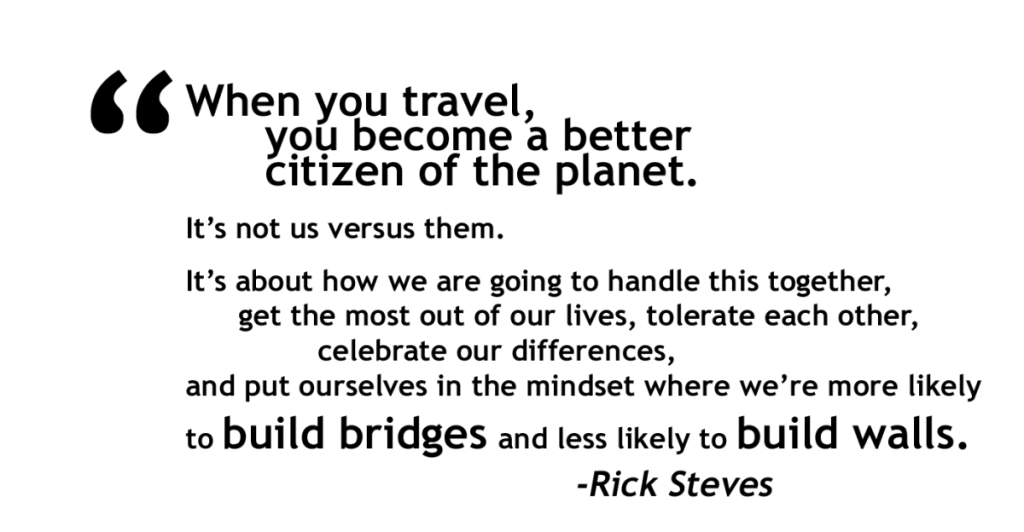Like most of America, I’m following with sadness the unfolding refugee situation in Europe. “Why is it happening?” “What can we do?” and “How to avoid this in the future?” are important questions for caring people to ask. Here’s my take, which was published in The Seattle Times today. I’ve also included a link below to an article on the topic by my fellow guidebook author Cameron Hewitt, who’s in the Balkans right now and witnessing the situation firsthand.

Today’s increased flow of refugees into Europe, while certainly newsworthy, needs to be kept in historical and practical perspective. (If you’re wondering how this might affect your future travels in Europe, I’d say not at all.) While this is the biggest such event since World War II, European history is a long and steady story of difficult refugee movements. (In the late 1940s, people were forcibly relocated from entire regions, causing great suffering.) There are refugee crises around the planet today that equal this event in pain and misery, but go unnoticed because they don’t affect the rich world. The big difference with the current story: The refugees are heading to Europe rather than to some other poor, war-torn, and dysfunctional region. Crisis-hungry commercial news is looking for something sensational to talk about 24/7. And desperate people in boats and trains entering Europe create dramatic images that catch our attention.
What’s the impact on Europe? Europe consists of roughly half a billion people. That’s 500 million. The refugee influx is in the hundreds of thousands (or single-digit millions, if Europeans open their doors a little wider). Europe can certainly absorb these people into its societies and workforces. Remember, European business leaders were the ones who favored admitting Turkey (with 75 million people) into the EU — not because they cared about struggling people, but because a graying Europe has an aging workforce that needs to be revitalized, which is what lots of young, hardworking immigrants can do. Europe needs immigrant labor as much as the USA does. Who else will pick our crops, tend our gardens, hang our drywall, and look after our children and aging parents? While that’s the clichéd image of an immigrant laborer, both Europe and the USA can attribute their economic success to smart, innovative, and industrious newcomers who contributed mightily to their adopted societies.
These refugees are leaving miserable and dangerous worlds, taking huge risks in the process. And terrible hardships are being experienced at Europe’s borders. As usual, Scandinavian countries are admitting more refugees per capita than many other nations. These countries’ acts of national kindness are compassionate and the decent thing to do. But even the most generous immigration policies of small nations like these will not alter the big-picture problem.
Is opening the doors of the rich world even wider — enough to allow in the tens of millions of people who’d like to swap worlds — the right answer? I don’t think so. Personally, I don’t want to see tiny countries such as Finland or Iceland overwhelmed by hundreds of thousands of refugees, which would fundamentally change their social structures.
I think the most compassionate and practical approach is to deal with the existing stream of refugees generously and help these immigrants assimilate into First World economies. But then we must focus on making the world they fled more stable and prosperous by changing our approach to the developing world. This can happen both from a trade policy point of view and from a military point of view (since, if we’re honest, most wars take place in the poor world and are fueled by rich countries with an eye on more fuel).
The flood of refugees we see on the news today is just the canary in the global economic coal mine. With the advent of climate refugees on the horizon and the specter of more societies breaking down in future decades, I fear this relative trickle will become a torrent. In the name of compassion and decency (as well as our own security and well-being, for those motivated purely by such things), it’s time for the rich world to get serious about making life more stable and comfortable in the places so many refugees are risking everything to leave.
Regardless of where you may live, there is no place like home. The challenge before us, along with giving today’s refugees a new home, is to help make the home they fled more livable.
Note: I’d welcome your comments on this difficult issue. And be sure to read Cameron Hewitt’s report from the Balkans where he has witnessed refugees on the move in person.










